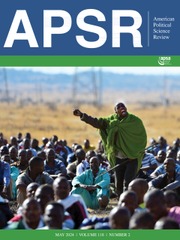No CrossRef data available.
Article contents
Partisan Leaning
Published online by Cambridge University Press: 28 March 2025
Abstract
A decisive voter’s exact ideological preferences can be hard to predict, even for seasoned candidates. We develop a novel theory of electoral competition where candidates are evaluated on ideological and nonideological dimensions. The key feature of our theory is that an electorate’s partisan leaning serves as a signal of the median voter’s ideological position where extreme leanings are more informative about voters than centrist leanings. We show that this leads to an endogenous sorting of districts between “extreme” and “centrist” and that an increase in the importance of candidate competence for voters increases polarization—but only in extreme districts. We evaluate our theory using data from mayoral elections in Brazil’s 95 largest municipalities and exploit COVID-19 as a shock to the salience of candidate competence. We show that COVID-19 increases the salience of competence in these elections, leading to increased political polarization, which is concentrated in cities with extreme partisan leanings.
- Type
- Research Article
- Information
- Copyright
- © The Author(s), 2025. Published by Cambridge University Press on behalf of American Political Science Association



Comments
No Comments have been published for this article.